
Welcome to Hyperion Records, a British classical label devoted to presenting high-quality recordings of music of all styles and from all periods from the twelfth century to the twenty-first.
Hyperion offers both CDs, and downloads in a number of formats. The site is also available in several languages.
Please use the dropdown buttons to set your preferred options, or use the checkbox to accept the defaults.

It was Schumann who confidently asserted that Schubert’s second set of Impromptus was really a sonata in disguise. ‘The first [piece] is so obviously the first movement of a sonata, so completely worked out and self-contained’, declared Schumann, ‘that there can be no doubt about it.’ It is true that the first and last of the pieces are in the same key of F minor, but neither is in sonata form; and while Beethoven managed to write a four-movement sonata entirely bereft of sonata form (Op 26), it would hardly have been a characteristic procedure for Schubert.
Schubert’s opening piece is conceived on a broad scale, and it contains a wealth of inspired material. The jagged opening theme is followed by a passage of gently rippling semiquavers whose thematic outline eventually gives rise to a wonderfully expressive melody in repeated chords. There is also a contrasting episode that has the pianist’s left hand, playing the melody, constantly crossing back and forth over the right. Despite the fact that it unfolds for the most part pianissimo, Schubert clearly wanted this passage played with peculiar intensity: the marking of appassionato for such intimate music is a characteristic gesture, and one we find again in a similar context in the slow movement of the E flat major piano trio, D929, and the ‘Notturno’ for piano trio, D897.
The second of the D935 Impromptus is similar in form and mood to the last of the six Moments musicaux, in the same key of A flat major—both are essentially a minuet and trio in Allegretto tempo; while the third Impromptu is a famous set of variations on a theme that recalls the melody Schubert borrowed from his incidental music to the play Rosamunde when he came to write the slow movement of his A minor string quartet, D804. Of the five variations, the third is an agitated piece in the minor, and the fourth broadens the tonal horizons of the piece by moving into the warmth of G flat major. The final variation is a delicate display piece, but Schubert characteristically brings proceedings to an end with a coda that is at once slower and simpler than the theme itself.
There is a decidedly Hungarian flavour to the last Impromptu of the set—not only in its strong off-beat accents, but also the scale-like improvisatory flourishes which seem to conjure up the sound of a cimbalom. The middle section, too, is not without its rushing scales, and there is a coda in which the music gathers pace, before eventually coming to an end with a scale sweeping down over the entire compass of the keyboard.
from notes by Misha Donat © 2015
C’est Schumann qui affirma avec assurance que le second recueil d’impromptus de Schubert était en réalité une sonate déguisée. «La première [pièce] est si manifestement le premier mouvement d’une sonate, si complètement conçue et indépendante», déclara Schumann, «que cela ne fait aucun doute.» Il est vrai que la première et la dernière pièces sont dans la même tonalité de fa mineur, mais aucune des deux n’est en forme sonate; et si Beethoven réussit à écrire une sonate en quatre mouvements entièrement dépourvue de forme sonate (op.26), ce procédé aurait difficilement pu être caractéristique de Schubert.
La première pièce de Schubert est conçue à grande échelle et contient beaucoup de matériel inspiré. Le thème initial irrégulier est suivi d’un passage en doubles croches qui ondulent doucement et dont le contour thématique donne finalement naissance à une mélodie merveilleusement expressive en accords répétés. Il y a aussi un épisode contrasté où la mélodie est confiée à la main gauche du pianiste, qui se croise constamment avec la main droite. Bien que la majeure partie de cet épisode se déroule pianissimo, Schubert voulait manifestement qu’il soit joué avec une grande intensité: l’indication appassionato pour une musique aussi intime est un geste caractéristique et on la retrouve dans un contexte analogue dans le mouvement lent du Trio avec piano en mi bémol majeur, D929, et dans le «Notturno» pour trio avec piano, D897.
Le deuxième impromptu du recueil D935 présente la même forme et la même atmosphère que le dernier des six Moments musicaux, dans la même tonalité de la bémol majeur—chacun des deux est essentiellement un menuet avec un trio dans un tempo Allegretto; et le troisième impromptu est un célèbre ensemble de variations sur un thème qui évoque la mélodie que Schubert emprunta à sa musique de scène pour la pièce Rosamunde lorsqu’il écrivit le mouvement lent de son Quatuor à cordes en la mineur, D804. Des cinq variations, la troisième est une pièce agitée dans le mode mineur et la quatrième élargit les perspectives tonales du morceau en passant dans la chaude tonalité de sol bémol majeur. La dernière variation est une pièce délicate de démonstration pianistique, mais Schubert mène d’une manière caractéristique la cérémonie à sa fin avec une coda qui est d’emblée plus lente et plus simple que le thème lui-même.
Le dernier impromptu du recueil dégage un parfum nettement hongrois—non seulement dans ses forts accents sur les temps faibles, mais en outre dans l’ornementation en gammes apparemment improvisées qui semblent faire surgir comme par magie le son du cymbalum. La section centrale, elle aussi, n’est pas dépourvue de gammes très rapides et il y a une coda où le tempo accélère, avant de s’achever finalement sur une gamme descendant toute l’étendue du clavier.
extrait des notes rédigées par Misha Donat © 2015
Français: Marie-Stella Pâris
Es war Schumann, der selbstsicher behauptete, dass Schuberts zweiter Impromptu-Zyklus in Wirklichkeit eine verkappte Sonate sei: „Der erste ist so offenbar der erste Satz einer Sonate, so vollkommen ausgeführt und abgeschlossen, daß gar kein Zweifel aufkommen kann.“ Es ist wahr, dass sowohl das erste als auch das letzte Stück dieselbe Tonart, f-Moll, haben, doch steht keines der beiden in Sonatenform; und während Beethoven eine viersätzige Sonate schrieb, in der die Sonatenhauptsatzform überhaupt nicht in Erscheinung tritt (op. 26), war dies kaum eine charakteristische Vorgehensweise Schuberts.
Schuberts Eröffnungsstück ist groß angelegt und enthält eine Fülle von inspiriertem Material. Auf das zerklüftete Anfangsthema folgt eine Passage von sich sanft kräuselnden Sechzehnteln, deren thematische Konturlinie schließlich zu einer herrlich expressiven Melodie in wiederholten Akkorden führt. Zudem erklingt eine kontrastierende Episode, bei der die linke Hand des Pianisten, die die Melodie spielt, ständig die rechte Hand überkreuzt und wieder zurückspringt. Obwohl sich dies zum größten Teil im Pianissimo entwickelt, wollte Schubert diese Passage offenbar mit besonderer Intensität aufgefasst wissen: die Anweisung „appassionato“ bei derart intimer Musik ist eine charakteristische Geste, die sich in einem ähnlichen Kontext im langsamen Satz des Klaviertrios Es-Dur, D 929, und in dem „Notturno“ für Klaviertrio, D 897, wiederfindet.
Das zweite der Impromptus D 935 erinnert sowohl in Form als auch Stimmung an das letzte der sechs Moments musicaux in derselben Tonart, As-Dur—beide sind praktisch ein Menuett und Trio im Allegretto-Tempo. Das dritte Impromptu hingegen ist ein berühmter Variationensatz über ein Thema, das an die Melodie aus der Zwischenaktmusik zu dem Schauspiel Rosamunde erinnert, die Schubert auch in dem langsamen Satz seines Streichquartetts a-Moll, D 804, verarbeitete. Von den insgesamt fünf Variationen ist die dritte ein bewegteres Stück in Moll, und die vierte erweitert den tonalen Horizont des Werks, indem sich die Musik hier in die warmen Gefilde von Ges-Dur bewegt. Die letzte Variation ist ein anmutiges Schaustückchen, das Schubert jedoch in charakteristischer Weise mit einer Coda abschließt, die sowohl langsamer als auch schlichter verläuft als das Thema selbst.
Das letzte Impromptu in dem Zyklus hat eine deutlich ungarische Einfärbung—nicht nur aufgrund seiner starken synkopischen Akzente, sondern auch aufgrund der improvisatorischen Läufe, die den Klang des Cimbaloms hervorzuzaubern scheinen. Auch im Mittelteil erklingen Tonleitern und in der Coda kommt die Musik noch mehr in Fahrt, bevor das Werk mit einem virtuosen Lauf von ganz oben bis nach ganz unten auf der Tastatur endet.
aus dem Begleittext von Misha Donat © 2015
Deutsch: Viola Scheffel
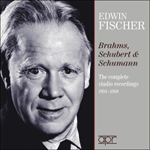 Edwin Fischer - The complete Brahms, Schubert & Schumann studio recordings, 1934-1950 Edwin Fischer - The complete Brahms, Schubert & Schumann studio recordings, 1934-1950 |
 Schubert: A Schubert Journey Schubert: A Schubert JourneyWelsh pianist Llŷr Williams is widely admired for his profound musical intelligence and the expressive and communicative nature of his interpretations. These recordings were made in conjunction with a critically lauded recital series at the Royal ...» More |
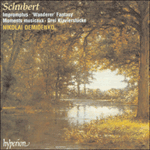 Schubert: Impromptus & other piano music Schubert: Impromptus & other piano music‘On these two CDs you hear two hours and 20 minutes of the most wonderful piano music anyone has ever written. A great deal of it is played with almos ... 'Una interpretación a nivel altísimo. Muy ben sonido' (CD Compact, Spain)» More |
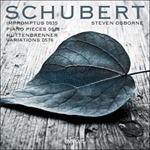 Schubert: Impromptus, Piano pieces & Variations Schubert: Impromptus, Piano pieces & VariationsLate Schubert masterpieces attain new heights under the fingers of Steven Osborne.» More |
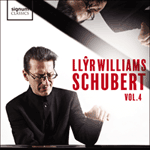 Schubert: Piano Music, Vol. 4 Schubert: Piano Music, Vol. 4Schubert's two sets of impromptus, the second arguably a sonata in all but name, date from 1827, the year before the composer's death. These lovely performances were recorded live in Cardiff in 2018.» More |
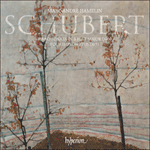 Schubert: Piano Sonata & Impromptus Schubert: Piano Sonata & ImpromptusThe heavenly lengths of Schubert’s last piano sonata and second set of impromptus: Marc-André Hamelin captures the other-worldliness of these sublime, quintessentially ‘late’ works as do few other pianists.» More |
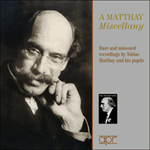 A Matthay Miscellany - Rare and unissued recordings by Tobias Matthay and his pupils A Matthay Miscellany - Rare and unissued recordings by Tobias Matthay and his pupilsThis final volume of 'The Matthay Pupils' presents most of his remaining students who left recordings, as well as the few discs Matthay himself made. Of particular interest is a selection from the almost unknown AFMC label which was affiliated to ...» More |
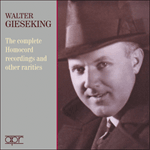 Walter Gieseking - The complete Homocord recordings and other rarities Walter Gieseking - The complete Homocord recordings and other raritiesWalter Gieseking is known as one of the greatest 20th-century pianists, and his playing of Debussy and Ravel in particular is often regarded as definitive. For most of his recording career he recorded for Columbia, but his earliest recordings were ...» More |

